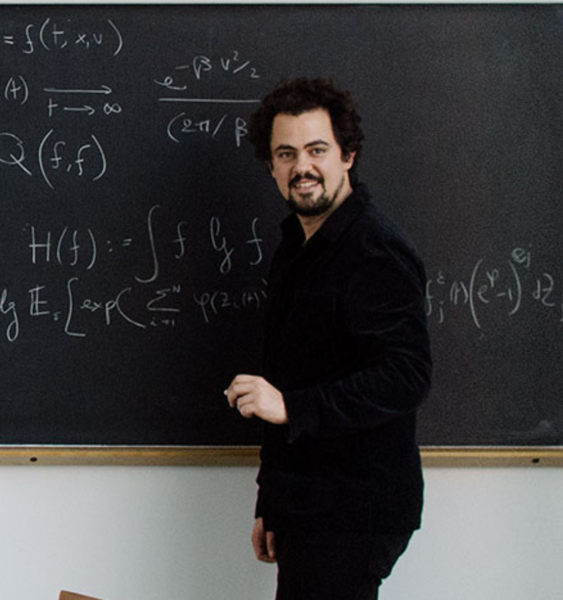Critical behaviour in spatial particle systems
Workshop
Berlin, 29 - 31 January, 2025
This workshop is devoted to certain classes of interacting spatial particle systems with phase transitions and connections to differential equations. The focus lies on particle systems with coagulation and fragmentation as well as on hard-sphere gas dynamics and the Boltzmann-Grad limit, furthermore also random spatial graphs and the like. The main goal is to describe the various critical behaviours and phase transitions that might occur and to compare their natures and physical effects to each other. Naturally, the workshop will discuss also related topics like large deviations, entropy and partial differential equations.
Minicourses by Alessia Nota and Sergio Simonella
- Two Minicourses on Thursday and Friday morning:
- Sergio Simonella, Università degli Studi di Roma La Sapienza, Italy
- Alessia Nota, Universita degli Studi dell'Aquila, Italy
- Scientific Talks:
- Luisa Andreis, Politecnico di Milano, Italy
- Miguel Escobedo Martínez, Universidad del País Vasco Barrio Sarriena s/n Lejona (Vizcaya), Spain
- Marina Ferreira, University of Toulouse, France
- Davide Gabrielli, Universita degli Studi dell'Aquila, Italy
- Daniel Heydecker, Imperial College London, UK
- Wolfgang König, Weierstrass Institute Berlin, Germany
- Jani Lukkarinen, University of Helsinki, Finland
- Alexander Zass, Weierstrass Institute Berlin, Germany
The get-together will take place on Wednesday evening at WIAS, Library building.
Minicourses

Alessia Nota
Recent advances on the Smoluchowski coagulation equation under non-equilibrium conditions
Schedule
Wednesday
13:00-13:45 Registration
13:45-13:50 Welcome Address
13:50-14:40 Miguel Escobedo
14:40-15:30 Daniel Heydecker
15:30-16:00 Coffee Break
16:00-16:50 Alexander Zass
16:50-17:40 Davide Gabrielli
18:00-??? Get-together
Thursday
9:00-10:30 Sergio Simonella
10:30-11:00 Coffee Break
11:00-12:30 Alessia Nota
12:30-13:50 Lunch Break
13:50-14:40 Luisa Andreis
14:40-15:30 Wolfgang König
15:30-16:00 Coffee Break
16:00-16:50 Marina Ferreira
16:50-17:40 Jani Lukkarinen
Friday
9:00-10:30 Sergio Simonella
10:30-11:00 Coffee Break
11:00-12:30 Alessia Nota
Audience
Titles and Abstracts
talk slides
The Smoluchowski’s coagulation equation is an integro-differential equation of kinetic type which provides a mean-field description for mass aggregation phenomena. Several results have been obtained during the last couple of decades, increasing the mathematical understanding of the Smoluchowski equation, such as well-posedness theory, self-similar behaviour, gelation, as well as some progress on its derivation from particle systems. More recently the analysis of coagulation equations has evolved towards generalizations, including other variables, such as multicomponent equations, or/and other terms, such as additional source or sink terms which naturally appears when modelling open systems. In this mini-course I will report on some recent developments on the problem of existence or non-existence of stationary solutions, both for single and multi-component systems, under non-equilibrium conditions which are induced by the addition of a source term for small cluster sizes. The most striking feature of these stationary solutions is that, whenever they exist, the solutions to multi-component systems exhibit an unusual “spontaneous localization” phenomenon: they localize along a line in the composition space as the total size of the particles increase. This is a universal property of multicomponent systems. I will then discuss the emergence of localization, both in stationary and in time dependent solutions to mass conserving coagulation equations, and some conjectures and open problems in this direction.
Sergio Simonella: Hard-sphere gases: deterministic dynamics with random initial data
talk slides
We will review the state of the art in the validity problem for a mathematical justification of fluid equations based on fundamental laws of classical mechanics. With the techniques currently available, such problems can be faced in some simple cases, using kinetic theory as an intermediate step. In particular, we will study deterministic, time-reversible dynamics with random initial data, in a low-density scaling. Under suitable assumptions on the initial measure, a strong chaos property is propagated in time, which also encodes the transition to irreversibility. This result is complemented by large deviation estimates and by a theory of small fluctuations, allowing to establish the connection between microscopic and hydrodynamic scales. Many of the open problems left require a deeper understanding of the coupling mechanisms between deterministic and stochastic dynamics.
Funded by the European Union (ERC CoG KiLiM, 101125162)
Luisa Andreis: Spatial particle processes with coagulation: rare events and
phase transition
talk slides
In this talk, we will give an overview on recent and past results on coagu-
lation processes, in particular in terms of their phase transition (gelation) and
their rare events. We will revise the link with random graphs, presenting recent
progresses in the study of large deviations for inhomogeneous random graphs
and random graphs with marks in this framework. We will underline some in-
teresting similarities between different models appearing when studying their
large deviation rate functions. This will serve to introduce and motivate a re-
cent approach that exploits the description of spatial coagulation processes in
terms of pairwise interacting random tree-like structures. This descriptions has
proved useful in proving large deviations for such Markov processes, as will be
presented in a following talk.
This talk is based on joint works with T. Iyer, W. König, H. Langhammer, E.
Magnanini, R. Patterson (WIAS Berlin) and M. Kolodziejczyk (PoliMi)
Miguel Escobedo: Power laws in ``soft Boltzmann'' equations via Landau currents.
talk slides
We first present some properties of the Landau mass current, in particular its uniqueness under some gauge condition, and prove that it is zero for the Maxwellians. Then we prove the existence of power laws stationary source solutions of the Boltzmann equation for some soft potentials. We show that on these power laws, the Landau mass current is not zero and there is a mass flux from small to large values of the energies. Finally I will discuss stability properties of the power laws with respect to small radial perturbation in terms of the linerization of the Boltzmann equation around them. (Joint work with F. Golse and L. Saint Raymond)
Marina Ferreira: Smoluchowski coagulation equation with a flux of dust particles
talk slides
We construct a time-dependent solution to the Smoluchowski coagulation equation with a constant flux of dust particles entering through the boundary at zero. The dust is instantaneously converted into particles and these flux solutions have linearly increasing mass. The construction is made for a general class of non-gelling coagulation kernels for which stationary non-equilibrium solutions, so-called constant flux solutions, exist. The proof relies on several limiting procedures on a family of solutions of equations with sources supported on ever smaller sizes. Flux solutions are expected to converge to a constant flux solution in the large time limit. We show that this is indeed true in the particular case of the constant kernel with zero initial data. (Based on a joint work with Aleksis Vuoksenmaa - U. Helsinki)
Davide Gabrielli: Stationary non-equilibrium states: old and new results
talk slides
Steady states are the simplest yet interesting situation in which typical non-equilibrium phenomena are observed. I will illustrate a series of results for non-equilibrium stationary states of boundary driven interacting stochastic particle systems. First I will recall some old exact results for specific one-dimensional models such as the simple exclusion and the KMP model, then I will illustrate some recent results on probabilistic and combinatorial representations of stationary states that allow a clearer perspective.
Daniel Heydecker: Bilinear coagulation via random raphs
talk slides
We consider the interaction clusters of Kac’s model of a dilute gas, where the spatial effects are mimicked by velocity-dependent interaction rates. For a toy model, the coagulation structure can be completely described by random graphs. Using this correspondence, we show that there is a phase transition at a finite gelation time $t_{\rm gel}$, when a single interaction cluster of size comparable to the whole system appears. Our general analysis shows that, except in edge cases, the gelation time is strictly smaller than the mean free time $t_{\rm mf}$.
Wolfgang König: Spatial particle processes with coagulation: Gibbs-measure approach, gelation, and Smoluchowski equation
talk slides
We study the spatial Marcus–Lushnikov process: according to a coagula-
tion kernel K, particle pairs merge into a single particle, and their masses
are united. We derive an explicit formula for the empirical process of the par-
ticle configuration at a given fixed time T in terms of a reference Poisson
point process, whose points are trajectories that coagulate into one particle
by time T. The non-coagulation between any two of them induces an expo-
nential pair-interaction.
Then we first give a large-deviation principle for the joint distri-
bution of the particle histories, in the limit as the number of initial atoms diverges and the ker-
nel scales as K/N. We analyse the minimiser(s) of the rate function and prove a law of large numbers. Furthermore, we give a criterion for the occurrence of a
gelation phase transition. This is joint work with Luisa Andreis, Heide Langhammer and Robert Patterson.
Jani Lukkarinen: Estimation of generation and propagation of chaos via cumulant hierarchies
talk slides
Propagation and generation of chaos is an important ingredient for rigorous control of applicability of kinetic theory, in general. Chaos is here understood as sufficient statistical independence of random variables related to the "kinetic" observables of the system. Cumulant hierarchy of these random variables thus often gives a way of controlling the evolution and degree of such independence, i.e., the degree of chaos in the system. In this talk, we will consider two, qualitatively different, example cases for which kinetic theory is believed to be applicable: the stochastic Kac model with random velocity exchange and the discrete nonlinear Schrodinger evolution (DNLS) with suitable random, spatially homogeneous initial data. In both cases, we set up suitable random variables and propose methods to control the evolution of their cumulant hierarchies. The talk is based on joint works with Sakari Pirnes and Aleksis Vuoksenmaa, and earlier works with Matteo Marcozzi, Alessia Nota, and Herbert Spohn.
Alexander Zass: Infinite-dimensional diffusions and depletion interaction for a model of colloids
talk slides
In this talk, we consider a dynamical version of the Asakura--Oosawa model of interacting hard spheres of two different sizes. We study their random diffusion dynamics, modelled with collision local times; describe the reversible measures; and observe the emergence of an attractive short-range depletion interaction between the large spheres. We also study the Gibbs measures associated to this new interaction, exploring connections to percolation and optimal packing.
This is joint work with Myriam Fradon.
Participants
- Luisa Andreis
- Maik Böhm
- Vincenzo Coscia
- Ana Damnjanovićc
- Théophile Dolmaire
- Miguel Escobedo
- Marina Ferreira
- Davide Gabrielli
- Lucio Galeati
- David Henriquez
- Daniel Heydecker
- Tejas Iyer
- Keunnam Kim
- Martin Kolodziejczyk
- Wolfgang König
- Jonas Köppl
- Jani Lukkarinen
- Elena Magnanini
- Alessia Nota
- Sergio Simonella
- Martin Slowik
- Sebastian Throm
- Cristina Toninelli
- Cesar Zarco Romero
- Alexander Zass
- Sebastian Zimper
- Willem van Zuijlen
The venue of the workshop is the main building of the Weierstrass Institute at Mohrenstraße 39 in 10117 Berlin-Mitte.
It is close to the U-Bahn station Hausvogteiplatz, on the U2 line. See a map and directions.
The scientific part of the event will take place in the Weierstrass Lecture Hall in the fourth floor. The get-together on Wednesday evening will take place in the library building around the corner.The organisers have reserved hotel rooms at Motel One Spittelmarkt (within walking distance) for invitees and members of SPP2265. Please send a message to csps25@wias-berlin.de if you would like to use that offer. If you individually organise some housing on your own, then there is the possibility to be reimbursed if the hotel price stays within reasonable bounds (e.g., below 100 Euros per night).
If you have any questions, please do not hesitate to
Homepage of the SPP2265.

